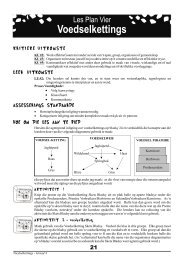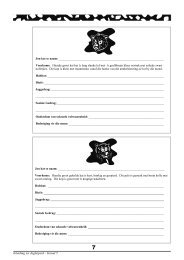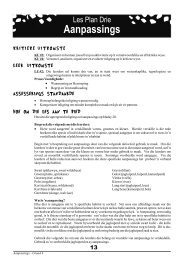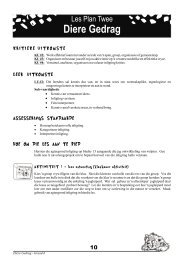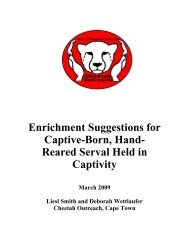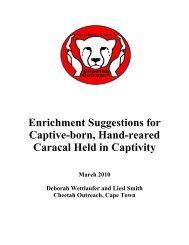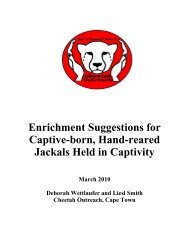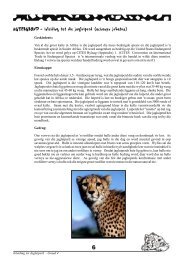Enrichment Suggestions for Captive-born, Hand-reared Meerkats ...
Enrichment Suggestions for Captive-born, Hand-reared Meerkats ...
Enrichment Suggestions for Captive-born, Hand-reared Meerkats ...
Create successful ePaper yourself
Turn your PDF publications into a flip-book with our unique Google optimized e-Paper software.
<strong>Enrichment</strong> <strong>Suggestions</strong> <strong>for</strong><br />
<strong>Captive</strong>-<strong>born</strong>, <strong>Hand</strong>-<strong>reared</strong><br />
<strong>Meerkats</strong> Held in Captivity<br />
March 2010<br />
Deborah Wettlaufer and Liesl Smith<br />
Cheetah Outreach, Cape Town
<strong>Enrichment</strong><br />
Animals in captivity have a lot of time on their hands. Whereas wild animals would fill<br />
their time with activities such as hunting, searching <strong>for</strong> water or shelter, protecting their<br />
territory or searching <strong>for</strong> a mate, captive animals very often are provided all of these.<br />
This could potentially create problems such as boredom, frustration, stereotypic<br />
behaviors and stress. Undesirable behaviours include self-injurious actions like excessive<br />
grooming; abnormal behaviours such as regurgitation and reingestion; aggressive<br />
behaviours; and stereotypic behaviours. Behaviour is an important indication of welfare<br />
and enrichment enhances welfare of animals in captivity.<br />
<strong>Enrichment</strong> becomes a valuable and necessary practice by creating activities or providing<br />
stimulation that maximizes their quality of life and leads to inquisitive behavior.<br />
By enriching the animal’s environment, you empower the animal to have control over its<br />
environment and you give the animal a choice. Ignoring something is still a choice.<br />
Apart from the fact that enrichment provides methods of passing time, the added physical<br />
and mental stimulation might also cause better reproductive success and improve visitor’s<br />
experiences since the image of healthy and well-adjusted animals are promoted.<br />
Different <strong>for</strong>ms of enrichment used <strong>for</strong> captive animals today include:<br />
Enclosure Design<br />
Feeding or <strong>for</strong>aging<br />
Visual and Auditory<br />
Olfactory<br />
Novel Objects and Toys<br />
Exercise<br />
Social Interaction/Tactile<br />
Behavioural Conditioning<br />
<strong>Enrichment</strong> should be considered part of the daily husbandry routine at all responsible<br />
animal care facilities. An efficient enrichment programme can be more important than the<br />
size of the enclosures the animals are kept in. Environmental enrichment is not a luxury<br />
but a management tool.<br />
When developing an enrichment programme at a captive facility, the habits, behaviours<br />
and nature of the species, and the personality of the specific individual need to be<br />
considered.<br />
<strong>Enrichment</strong> suggestions <strong>for</strong> the meerkat include the following:<br />
Produced by Cheetah Outreach (Last Updated: November 2011)<br />
cheetah@intekom.co.za Http://www.cheetah.co.za<br />
Homes Provided by Heartland and Eikendal<br />
2
Enclosure Design<br />
Enclosures should be designed in order to address the needs <strong>for</strong> space, shade and sun,<br />
shelter, privacy, stimulation, elevation and where appropriate, public viewing.<br />
When designing enclosure layouts the following should be incorporated:<br />
Shade and Areas of Sun<br />
<strong>Meerkats</strong> regulate their body temperature by exposing the sparsely covered skin on their<br />
bellies to the sun when it’s cold. To reduce heat, they sprawl on their bellies on cool<br />
ground in the shade. The meerkat enclosure at Cheetah Outreach is built with low walls<br />
so it receives full exposure to the sun. A sheltered area built with tin and shade cloth<br />
provides shelter from wind and rain as well as shade on hot days.<br />
Shelter/Den<br />
In the wild, meerkats sleep and shelter in underground dens accessed by a network of<br />
tunnels. Our meerkats use a plastic pipe to enter an enclosed wooden box that acts as a<br />
den <strong>for</strong> them. Inside a warm bed is supplemented with hot water bottles during winter<br />
nights.<br />
Produced by Cheetah Outreach (Last Updated: November 2011)<br />
cheetah@intekom.co.za Http://www.cheetah.co.za<br />
Homes Provided by Heartland and Eikendal<br />
3
Water<br />
Water should be provided in solid, non-toxic containers. Containers should be placed in<br />
an easily accessible and shaded area. All water containers should be disinfected on a<br />
regular basis.<br />
Logs<br />
Big logs can be packed at angles to one another. Alternatively flat pieces of logs can be<br />
stacked loosely on top of and against one another. Logs provide areas to <strong>for</strong>age in, to<br />
hide food in, and elevated sites to sit or stand on.<br />
Elevated Areas<br />
In the wild meerkats standing guard perch on lookout-posts, such as dead trees, shrubs<br />
and termite mounds, watching <strong>for</strong> approaching predators. In captivity elevated areas in<br />
the <strong>for</strong>m of elevated walkways, logs, rocks and mounds of dirt, give meerkats a sense of<br />
Produced by Cheetah Outreach (Last Updated: November 2011)<br />
cheetah@intekom.co.za Http://www.cheetah.co.za<br />
Homes Provided by Heartland and Eikendal<br />
4
security by allowing them to survey surrounding areas. At Cheetah Outreach our<br />
meerkats have access to walkways level with the low cement walls so they can see out of<br />
their enclosure as well as mounds of dirt, large rocks and a tower built of poles.<br />
Areas <strong>for</strong> Digging<br />
<strong>Meerkats</strong> are burrowing animals and spend a large percentage of their time digging and<br />
maintaining tunnels or digging <strong>for</strong> insects. Most of the enclosure at Cheetah Outreach is<br />
composed of bare earth so our meerkats can dig and <strong>for</strong>age.<br />
Produced by Cheetah Outreach (Last Updated: November 2011)<br />
cheetah@intekom.co.za Http://www.cheetah.co.za<br />
Homes Provided by Heartland and Eikendal<br />
5
Vegetation<br />
In our meerkat enclosure, we have planted indigenous vegetation that replicates their<br />
naturally arid habitat. Vegetation provides cover as well as areas <strong>for</strong> <strong>for</strong>aging.<br />
Privacy<br />
Concealed, private areas should be provided in all meerkat enclosures. Concrete walls,<br />
shade cloth and vegetation can be used to provide privacy. Besides a den built of a<br />
closed wooden box accessed by pipe, our meerkats also have a network of plastic tubes<br />
dug into mounds that they can hide in.<br />
Security<br />
Meerkat enclosures should be roofed and have a rein<strong>for</strong>ced concrete foundation to<br />
prevent escape through climbing or digging. The Meerkat enclosure at Cheetah Outreach<br />
is built with concrete walls and a base of concrete rein<strong>for</strong>ced with rock and wire to<br />
prevent meerkats from digging out. The roof and sides of the enclosure are screened with<br />
wire fencing to keep the meerkats from climbing out.<br />
Produced by Cheetah Outreach (Last Updated: November 2011)<br />
cheetah@intekom.co.za Http://www.cheetah.co.za<br />
Homes Provided by Heartland and Eikendal<br />
6
Habitat modifications<br />
Habitat modification by moving and changing exhibits inside the enclosures might<br />
provide stimulation.<br />
Feeding<br />
Hiding Food<br />
<strong>Meerkats</strong> are <strong>for</strong>agers and hiding food in their enclosure encourages this natural feeding<br />
behaviour. At Cheetah Outreach meat is often placed in holes that have been drilled in a<br />
dead tree stump and logs. Food is sometimes placed inside pine cones, a plastic treat ball<br />
or toilet paper rolls to encourage our meerkats to use their cognitive skills to retrieve food<br />
by either grabbing with teeth or claws.<br />
Burying Food<br />
While <strong>for</strong>aging, meerkats spend much of their time digging <strong>for</strong> food and use the long<br />
claws on their <strong>for</strong>efeet to dig prey out. Burying insects in a sandbox where they can’t<br />
escape encourages our meerkats to search <strong>for</strong> and dig up their food.<br />
Foraging <strong>for</strong> Food<br />
Since meerkats spend much time in the wild <strong>for</strong>aging <strong>for</strong> food, we try to encourage<br />
<strong>for</strong>aging during walks or visits to other enclosures. While on walks or in unfamiliar<br />
enclosures, our meerkats are constantly searching and digging <strong>for</strong> food. By overturning<br />
logs and rocks, we increase the chances of them finding insects and other prey. During<br />
walks, our meerkats have caught and eaten snakes, frogs, lizards and insects.<br />
Produced by Cheetah Outreach (Last Updated: November 2011)<br />
cheetah@intekom.co.za Http://www.cheetah.co.za<br />
Homes Provided by Heartland and Eikendal<br />
7
Day-old Chicks<br />
Dead baby chicks can supplement normal diet and add enrichment by prolonging the<br />
feeding activity. Chicks should be de-yolked prior to feeding.<br />
Meat with Fur<br />
Sections of horsemeat with fur can be given. Apart from providing roughage, it also<br />
changes the texture of the food and increases the length of feeding activity.<br />
Produced by Cheetah Outreach (Last Updated: November 2011)<br />
cheetah@intekom.co.za Http://www.cheetah.co.za<br />
Homes Provided by Heartland and Eikendal<br />
8
Live Insects<br />
Wild meerkats are primarily insectivores, with about 82% of their diet composed of<br />
insects. Not only are insects nutritious <strong>for</strong> them but giving them live provides much<br />
enrichment <strong>for</strong> meerkats in captivity.<br />
Whole Fruits and Vegetables<br />
Feeding whole gem squash or corn on the cob encourages meerkats to work <strong>for</strong> their food<br />
by digging, picking and chewing flesh and seeds or corn kernels out. A squash or piece<br />
of corn cob can keep meerkats busy <strong>for</strong> an hour or more.<br />
Produced by Cheetah Outreach (Last Updated: November 2011)<br />
cheetah@intekom.co.za Http://www.cheetah.co.za<br />
Homes Provided by Heartland and Eikendal<br />
9
Pumpkins<br />
Hallowing out a large pumpkin and leaving some of the seeds inside will keep meerkats<br />
busy <strong>for</strong> a long time. Holes in the pumpkin allow meerkats to reach inside and grab seeds<br />
with teeth or claws.<br />
Visual and Auditory<br />
Objects that provide visual and auditory stimulation include the following:<br />
Outside Stimuli<br />
Passing trains, motorbikes, running children, other animals, laborers, bicycles and<br />
wheelchairs. Having visual access to some of these not only provides mental stimulation<br />
but also increases activity as the meerkats often run back and <strong>for</strong>th in their enclosure to<br />
Produced by Cheetah Outreach (Last Updated: November 2011)<br />
cheetah@intekom.co.za Http://www.cheetah.co.za<br />
Homes Provided by Heartland and Eikendal<br />
10
get a better look at outside activity. Having an elevated ledge gives the meerkats an<br />
excellent vantage point to use their acute eyesight to view all activities in the surrounding<br />
area.<br />
Other Animals<br />
Walking different types of animals on their leads past the meerkat enclosure provides<br />
much interest and stimulation. The meerkats become excited and very vocal when<br />
another animal is walked by their enclosure or up to the fence.<br />
Olfactory<br />
<strong>Meerkats</strong> have a phenomenal sense of smell and much time is spent sniffing and marking<br />
objects, both inside and outside their enclosure.<br />
Providing Scents<br />
A number of scents have been tried with the meerkats at Cheetah Outreach. They have<br />
responded best to fresh herbs, such as fresh parsley, coriander and catnip, which they rub<br />
in and chew on. They have also shown much interest in colognes sprayed on objects,<br />
which they rub against and then mark with their anal glands. Scented items should only<br />
be given in open, airy areas to provide adequate ventilation.<br />
Moving Animals Between Enclosures<br />
The meerkats can be moved into a <strong>for</strong>eign or lesser-known enclosure. It is important that<br />
the enclosure has a fenced roof to prevent escape and that the meerkats are constantly<br />
supervised. If this is not possible the animals should be walked on lead and collar.<br />
Intense sniffing, investigating and digging may be observed.<br />
Moving Objects Between Enclosures.<br />
Some of the exhibits can be moved from one enclosure to another, such as small crates<br />
and boxes . The health status of all animals should always be known. Objects should<br />
never be moved from a sick or compromised animal to the enclosure of a healthy animal.<br />
Produced by Cheetah Outreach (Last Updated: November 2011)<br />
cheetah@intekom.co.za Http://www.cheetah.co.za<br />
Homes Provided by Heartland and Eikendal<br />
11
Novel Objects<br />
<strong>Meerkats</strong> are naturally inquisitive animals so any novel objects that encourage them to<br />
search, sniff and scent-mark, dig or probe with their long claws provides good<br />
enrichment. Novel objects are a good way of hiding food and encouraging <strong>for</strong>aging<br />
behaviours.<br />
Never leave any toys unsupervised with the animals.<br />
Papier-mâché Ball<br />
Balls with holes in them arouse the curiosity of meerkats and encourage them to probe<br />
inside. Dry cat food in a papier-mâché ball makes a rattling noise and attracts their<br />
attention. The meerkats at Cheetah Outreach will spend much time sticking paws inside<br />
the ball and retrieving pieces of dry cat food.<br />
Cardboard Boxes<br />
Since meerkats are burrowing animals, they enjoy entering small concealed spaces. The<br />
meerkats at Cheetah Outreach love exploring boxes and sometimes playing in them.<br />
Exercise<br />
Exercise is essential and is a part of husbandry that cannot be compromised on. Not only<br />
does the activity help to maintain a healthy physical condition, but it also provides<br />
excellent mental stimulation. Exercise can be provided by the following means:<br />
Play<br />
Play is an important part of social interaction and the meerkats at Cheetah Outreach<br />
spend a lot of time playing with each other. Play also promotes activity and provides<br />
good exercise.<br />
Produced by Cheetah Outreach (Last Updated: November 2011)<br />
cheetah@intekom.co.za Http://www.cheetah.co.za<br />
Homes Provided by Heartland and Eikendal<br />
12
Walks<br />
Walks can provide the handler with many opportunities to enrich a meerkat’s life. New<br />
and different environments can provide a variety of smells and sights to investigate. Not<br />
only do walks provide exercise to the meerkats but they give them great opportunities to<br />
<strong>for</strong>age <strong>for</strong> food as they would in the wild. During walks, handlers often turn logs and<br />
rocks over to encourage digging. The meerkats at Cheetah Outreach also display antipredator<br />
behaviour during walks, stopping every few minutes to sit upright on hind legs<br />
to scan the skies and surrounding area <strong>for</strong> any signs of danger.<br />
Social interaction/Tactile<br />
<strong>Meerkats</strong> are among the most social animals on Earth so social interaction, especially<br />
with other meerkats, is essential to their well-being.<br />
Interaction with Staff/Volunteers<br />
Produced by Cheetah Outreach (Last Updated: November 2011)<br />
cheetah@intekom.co.za Http://www.cheetah.co.za<br />
Homes Provided by Heartland and Eikendal<br />
13
For animals kept in captivity and thus exposed to people, it is to their benefit to view<br />
humans positively. This greatly minimizes one of the main stresses in captivity. Both<br />
meerkats at Cheetah Outreach have been raised by people and are imprinted on humans<br />
so require attention and interaction from handlers on a daily basis.<br />
Interaction with Other <strong>Meerkats</strong><br />
Since meerkats in the wild live in groups of 2 to 50 members, having the companionship<br />
of their own species is essential <strong>for</strong> their well-being in captivity.<br />
Grooming and playing with each other strengthens social bonds. Sparring and playfighting<br />
allows young meerkats to practice skills and adults to establish dominance in the<br />
pack. The meerkats at Cheetah Outreach often engage in play-fighting, grappling and<br />
wrestling with each other.<br />
Produced by Cheetah Outreach (Last Updated: November 2011)<br />
cheetah@intekom.co.za Http://www.cheetah.co.za<br />
Homes Provided by Heartland and Eikendal<br />
14
Interaction with Other Animals<br />
Seeing, smelling and interacting with other animals through a fence or at a distance can<br />
greatly enrich a captive meerkat’s life. When encountering larger predators, the meerkats<br />
may show threat displays or even engage in mock attacks.<br />
This should be a positive experience <strong>for</strong> the animals and not lead to anxiety. Care should<br />
be taken to assess the demeanor and behaviour of all animals carefully.<br />
Interaction with the Public<br />
At Cheetah Outreach, the meerkats don’t take part in encounters with the public but they<br />
have much interaction with tour groups and visitors through the fence of their enclosure.<br />
Occasionally they will meet visitors on walks under the supervision of their handlers.<br />
Behavioral Conditioning<br />
Behavioral conditioning is very important since it provides mental and intellectual<br />
stimulation. The level of conditioning depends on the individual.<br />
Lead Walking<br />
Lead walking begins at an early age in order <strong>for</strong> young animals to get accustomed to the<br />
restricted feeling of harness and lead. Lead walking is important <strong>for</strong> all ambassador<br />
animals. With the meerkats at Cheetah Outreach, it allows them to go on walks and<br />
explore different areas of the facility.<br />
Produced by Cheetah Outreach (Last Updated: November 2011)<br />
cheetah@intekom.co.za Http://www.cheetah.co.za<br />
Homes Provided by Heartland and Eikendal<br />
15
Produced by Cheetah Outreach (Last Updated: November 2011)<br />
cheetah@intekom.co.za Http://www.cheetah.co.za<br />
Homes Provided by Heartland and Eikendal<br />
16



